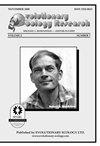Does water depth or diet divergence predict progress towards ecological speciation in whitefish radiations
Q2 Agricultural and Biological Sciences
引用次数: 14
Abstract
Question: Is the extent of genetic divergence between sympatric whitefish ecotypes – a proxy for progress towards speciation – related to the extent of ecological divergence in spawning depth or diet? Study system: Whitefish (Coregonus spp.) that have diversified into two or more sympatric ecotypes in subalpine Swiss lakes. Sympatric ecotypes vary in the extent of reproductive isolation. Analytical methods: We measured the degree of spawning depth differentiation based on the depth-at-capture of different ecotypes. We estimated diet differentiation between ecotypes as Mahalanobis distances from stable isotopes. We compared each of these to genetic differentiation measured from AFLP data, using modified correlation tests and phylogenetically independent contrasts to account for non-independence of comparisons in lakes with more than two ecotypes. Results: We found that the magnitude of divergence in spawning depth was generally – albeit only marginally significantly – associated with the extent of genetic divergence between sympatric ecotypes. This effect was clearly stronger than the effect of diet divergence, which was not associated with genetic differentiation. Furthermore, there was no evidence for an interactive effect of depth and diet divergence on progress towards speciation.水深或饮食差异是否能预测白鱼辐射中生态物种形成的进展
问题:同域白鱼生态型之间的遗传差异程度——物种形成进程的代表——与产卵深度或饮食的生态差异程度有关吗?研究系统:瑞士亚高山湖泊中已分化为两种或两种以上同域生态型的白鱼(Coregonus spp.)。同域生态型的生殖隔离程度各不相同。分析方法:根据不同生态型的捕获深度来衡量产卵深度分化程度。我们估计生态型之间的饮食差异是马氏鱼与稳定同位素的距离。我们将这些数据与从AFLP数据中测量的遗传分化进行了比较,使用改进的相关测试和系统发育独立的对比来解释具有两个以上生态型的湖泊中比较的非独立性。结果:我们发现产卵深度的差异程度通常与同域生态类型之间的遗传差异程度相关,尽管只是略微显着。这种影响明显强于饮食差异的影响,而饮食差异与遗传分化无关。此外,没有证据表明深度和饮食差异对物种形成进程有相互作用。
本文章由计算机程序翻译,如有差异,请以英文原文为准。
求助全文
约1分钟内获得全文
求助全文
来源期刊

Evolutionary Ecology Research
生物-进化生物学
自引率
0.00%
发文量
0
审稿时长
>12 weeks
期刊介绍:
Evolutionary Ecology Research publishes original research contributions focusing on the overlap between ecology
and evolution. Papers may treat any taxon or be general. They may be empirical, theoretical or a combination of the two.
EER prefers conceptual contributions that take intellectual risks or that test ideas.
 求助内容:
求助内容: 应助结果提醒方式:
应助结果提醒方式:


